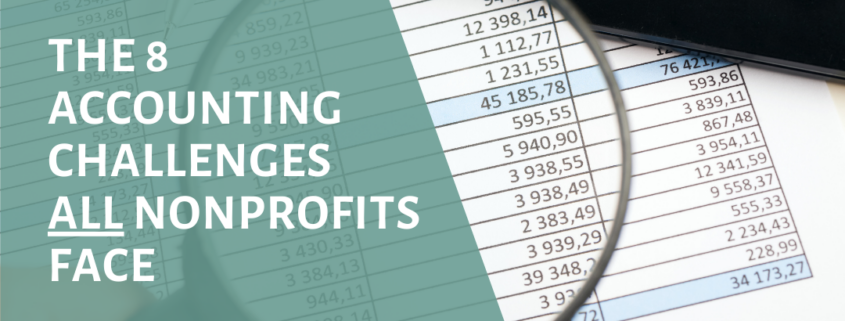The 8 Nonprofit Accounting Challenges You Need to Conquer
Your nonprofit organization will run into a range of accounting challenges every day.
From managing cash flow to reimbursing employee expenses to creating reports for your board of directors, the challenges just keep on coming.
And as a nonprofit founder or executive director, you may not have the background in accounting or finance to take them all on confidently.
But you’ll need to learn to conquer at least the most common nonprofit accounting challenges if you’re going to set your organization up for growth.
This article will walk you through the biggest challenges and common accounting problems that all nonprofits face. And we’ll give you some tips for how to overcome them to keep your organization out of trouble and your mission moving full-speed ahead.
So let’s get started…
1. Recording donations, paying invoices, preparing invoices, processing expenses…
Your first nonprofit accounting challenge has a name: bookkeeping.
You need accurate and timely financial data to make smart decisions for your nonprofit, just like any business does.
But when your accounting team consists of part-time bookkeepers, volunteer accountants, and multi-tasking team members, then it’s hard to get all your receipts, invoices, donations, expenses, and payroll transactions into the system accurately.

Those invoices aren’t going to enter themselves…
That’s not to mention “on-time.”
Because if you enter receipts, invoices, and credit card transactions every few weeks (or worse, “whenever we get around to it”), then you’ll always be playing catch-up.
So how can you take charge to ensure you have accurate financial data when you need it?
Start by creating and documenting a repeatable process and schedule for entering all your data. And follow it each time. Following a process may save you when you’ve got part-time help, volunteers, or even employee turnover (it happens).
Next, implementing simple accounting software can save your team hours every month by automating tasks like importing bank and credit card transactions. And it ensures that your books are up-to-date when you need them.
Another option is to hire an outsourced accounting service that specializes in nonprofits.
They’ll make sure your revenues and expenses get entered correctly and on time. So you don’t have to wait on your part-time accountant or worry about the accuracy of your numbers.
2. Preparing Accurate Financial Reports
Once you have accurate financial data, you’ve got to be able to make sense of it.
And that’s what financial reports do for you.
At the minimum, you’ll need the five essential nonprofit financial reports:
- Statement of Financial Position (or Balance Sheet)
- Summary of Activities (or Income Statement/Profit & Loss)
- Statement of Cash Flows
- Budget to Actual
- IRS Form 990
Depending on the complexity of your organization, you may need additional reports. Such as reports for tracking your donations, keeping track of your grant funds, and knowing which money is subject to program restrictions.
Your financial reports must be timely, accurate, and consistent.
And the last one— consistency— is a significant challenge for many nonprofits.
Many nonprofit accounting teams are self-trained. And many CPAs or general accountants aren’t familiar with the specific challenges that a nonprofit faces.
For this reason, nonprofit leaders often struggle to get reports that look the same month after month.
When you can’t make sense of your reports due to inconsistency, you’ll find yourself embarrassed in front of the board or failing to land the grant you’ve been counting on.
Want to learn to read nonprofit financial reports? Our Masterclass on Nonprofit Accounting and Reporting is a simple 3-video introduction to the basics of nonprofit accounting. Need a crash course in how to make sense of your finances? Click here to grab it free!
3. Modernizing Accounting Systems
A nonprofit accountant’s favorite phrase is, “Because this is how we’ve always done it.”
And that’s why so many nonprofit financial offices look like a scene from a classic movie– filled with overstuffed filing cabinets and a 3-foot high stack of paper invoices in the inbox.
Modernizing your accounting system is a major nonprofit accounting challenge.
But it’s one you must tackle to make your organization efficient and effective at carrying out your mission.
Modernization for your nonprofit accounting department means adopting simple, straightforward systems that rely on technology to save you tons of time and effort.
Updating your accounting software can allow you to automate basic tasks, like entering bank deposits and credit card transitions.
But other modernization solutions can help you save even more time. here are just some things you can do:
- Digitize employee expense reporting (stop losing receipts!)
- Pay your bills/vendors online
- Eliminate 90% of the paper from your office
- Connect your fundraising system to your accounting system
- Securely view and manage your accounts from anywhere
If you’re wondering which nonprofit tech solutions could benefit you, check out our list of the top tech solutions.
You can also ask for advice from nonprofits in your community or hire a nonprofit accounting or consulting service to help you identify your needs.
4. Accounting for Grants
Grants can be a game-changer for a small or mid-sized nonprofit.
So it’s natural that you’re excited to start writing grants. Until you realize what it does to your accounting department…
Adding grants to your revenue portfolio raises all sorts of new accounting challenges for a nonprofit.
First, you’ll need updated and accurate (generally audited or reviewed) financials to secure the grant. Then you’ll need to provide your grantmaker with regular financial updates to keep your funding.
Secondly, many grants are issued only for certain types of expenses or specific programs.
In many cases, you can’t use grant funds to cover general operating expenses, like payroll.
That means you need to track your grant funds separately to know where how much you’ve spent and what you spent it on, so you can report back to the grantmaker.
Finally, specific rules apply to how to recognize grant revenue on your books.
If you’re dealing with grants, it’s risky and time-consuming to try to do it on your own.
You’ll probably want to hire an experienced nonprofit CFO. Or find an external service with extensive experience and expertise handling the specific challenges of nonprofit teams.
5. Managing Payroll
Payroll presents unique compliance challenges for a nonprofit accounting team.
First, many nonprofits have employees, contractors, and volunteers.
It’s not always easy to figure out how to classify everyone. But you’ll need to get it right so you can withhold and pay your federal and state payroll taxes appropriately.
(Yes, nonprofit employees pay payroll taxes. And nonprofit companies do too.)
You also may need to track your employees’ pay based on the job function they’re performing.
When a nonprofit employee occupies multiple roles— like opening the mail AND running programs— you should allocate their salary based on how much time they spend doing each role.
Why does this matter?
Let’s imagine one of your employees spends 2 days a week in the office helping with administrative tasks.
And the other 3 days, they are in the field running a service project.
If the service project has grant funding, their salary may qualify to be covered by grant funds for those days. But the other 2 days wouldn’t be eligible.
If you’re not tracking your payroll by job function, you could be underutilizing your grant funds. OR misusing your grant funds.
And applying functional expense allocation to your payroll can help you maximize your funds AND comply with best practices for transparency.
An experienced accountant will help you navigate nonprofit payroll challenges. But you’ll probably still want to contract an external payroll service like Onpay or Paychex to handle payroll processing.
They’ll help simplify your payroll distribution and tax management, and you’ll have access to their support team when you have questions.
6. Filing Tax Returns
You didn’t think you were going to get out of this just because you’re tax-exempt, did you?
That’s right– nonprofits have tax accounting challenges too!
The IRS requires nonprofit organizations to file a 990 every year to maintain their tax-exempt status.
If you don’t file a return for 3 years, your tax-exempt status will be automatically revoked!
So this one’s essential. If you have updated financials, you may be able to handle this yourself (it’s not that hard). But many nonprofits prefer to trust a CPA to handle it for them.
A bonus of working with a nonprofit accounting service, like The Charity CFO, is that we’ll file your IRS form 990 for you. Plus, we can tell you what other taxes you might have to file or pay depending on your location and operations, like state taxes, sales taxes, or payroll taxes.
7. Dealing with the Board of Directors
Your relationship with the board of directors is one of the trickiest challenges you’ll face as a nonprofit leader.
It’s not exclusively a financial relationship. But financial oversight is one of the critical roles of your board of directors. So, for better or for worse, accounting and reporting will play a significant role in your relationship.
Suppose your board has members with a lot of for-profit business experience…
They may expect that they’ll “get” nonprofit finances automatically— it’s all business after all, right?
But there are actually a lot of differences between for-profit and nonprofit accounting.
For instance…
The rules for recognizing donation revenue say that you have to record donation revenue when it’s pledged, instead of when you receive it.
This one minor tweak can lead to huge quarterly “losses” on paper that would strike fear into the heart of a for-profit executive. And if you’re not prepared to explain and defend your numbers, it can lead to some high-tension situations.
You can improve your board management skills by leaning on a solid network of nonprofit leaders. So when unfamiliar situations arise, you can ask for advice from people who have navigated similar situations.
Another option is to employ a contractor or an experienced nonprofit CFO.
At The Charity CFO, we help provide expert guidance to all of our clients on managing board interactions. And if one of your board members has questions you can’t answer, we’ll help you understand it so that you can help put their mind at ease.
7. Implementing Effective Controls
You’ll have to get very familiar with the words compliance and transparency as a nonprofit executive.
Nonprofits are challenged to keep everything out in the open when it comes to accounting and bookkeeping.
To maintain a donor-friendly and audit-ready nonprofit, you need a series of internal controls to ensure you comply with industry best practices.
According to First Nonprofit Foundation, “internal controls are policies and procedures that protect the assets of an organization, create reliable financial reporting, promote compliance with laws and regulations, and facilitate effective and efficient operations. They relate to accounting, to reporting, and to the organization’s communication processes.“
You’ll need established and documented policies for things like:
- Segregation of accounting duties (so different people handle incoming and outgoing money)
- Physical controls, like secure passwords and locked cabinets, to protect checkbooks and financial data
- Conflict of interest policies
- A financial whistleblower policy (per the Sarbanes-Oxley Act)
- And more…
To keep things above board, someone other than your bookkeeper should be responsible for signing checks.
And since the board is responsible for financial oversight, your finance chair shouldn’t be moonlighting as a volunteer accountant!
If you’re not sure which internal controls you need, well, that’s part of the problem!
In most cases, ignorance is not an excuse for non-compliance.
So do your research. Talk with your nonprofit network. Or hire a professional to help you be sure you’re doing everything you need to protect your organization.
Because without adequate internal controls, our last nonprofit accounting challenge will be your worst nightmare…
8. Preparing for (and passing) audits
There are few scarier words than “audit” in the English language (and this comes from a team of former auditors!).
And in many cases, passing an independent audit is the biggest accounting challenge a nonprofit will face– especially if you’re not on top of challenges 1 through 7 above…
If you wait until you NEED an audit to start preparing for one, then you could be looking at months of work and tens of thousands of dollars in expense to unravel your accounts.
To pass an independent nonprofit audit, you must comply with generally accepted accounting principles (GAAP). GAAP includes standards for financial statements and robust internal controls (maybe those sound familiar), among other things.
Not every nonprofit needs to be audited, but if you’re big enough, located in certain states, or depend on a lot of grant funding, you may need it.
And even if you don’t need an audit today, you will need it someday if you intend to grow your mission.
That’s why the best time to start preparing for that first audit is right now!
Because the longer you put it off, the more time (and $$$) it will take for your CPA to figure it out later.
Want the Easiest Solution to Your Nonprofit Accounting Challenges?
Nonprofit accounting is not for the faint of heart.
The nonprofit accounting challenges detailed here are the biggest and most common. But every nonprofit is unique and presents its own unique problems.
Building an in-house team that’s capable of tackling these challenges is expensive. And experienced nonprofit accountants and bookkeepers are hard to find. If you’re lucky enough to have a good one, finding and training a replacement can be a full-time job when you lose them due to retirement or turnover.
That’s why many modern nonprofits are turning to a professional accounting service to handle their accounting and bookkeeping needs.
At The Charity CFO, we help over 100+ small and medium-sized nonprofits and charities manage their accounting and bookkeeping from start to finish.
We can help you pay bills, classify credit card transactions, enter & pay vendor invoices, record your payroll expenses, reconcile your monthly accounts, and create consistent, easy-to-read monthly reports.
With 5 former auditors on staff, we know exactly how to prepare you for a successful audit. Your books will always be audit-ready, so there’s never any catch-up to do when you need to write a grant or run financial statements.
Our team of former nonprofit CPAs, CFOs, board members, and auditors have seen just about every situation a nonprofit can face.
So whether you need help setting up controls, a strategy for fundraising, tips on scaling, or advice on how to work better with your board, we’re here to help!
Our expertise is available to ALL of our clients, free of additional charge.
So if you’re looking for ONE solution to conquer ALL of your biggest nonprofit accounting challenges, reach out to us today. And stop worrying about your books so you can focus on your mission.
Book a free consultation with The Charity CFO









